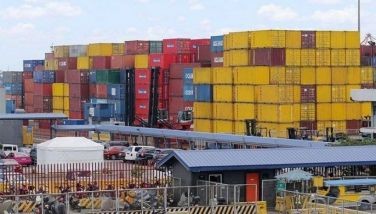Changing rules midstream

By this time, the country’s two water concessionaires should have filed their respective motions asking the Supreme Court to reconsider its recent decision penalizing them for violating provisions of the Clean Water Act.
According to Maynilad president Ramoncito Fernandez, they had until Oct. 2, or 15 days after receipt of the court’s ruling last Sept. 18, to file the motion. Even their regulator, the Metropolitan Waterworks and Sewerage System (MWSS) is expected to file a separate motion on or before the deadline.
Fernandez said in a news report that should the SC reject the motion and insist on accelerating the implementation and building of all necessary waste water treatment plants, the impact on consumers’ water tariff would be immediate.
Based on Maynilad’s computation, the increase will be around P16 per cubic meter which will be immediate implemented. Adding to the consumers woes is the impact on the already bad traffic situation due to simultaneous digging of roads to comply with the SC ruling.
The SC last month found Manila Water and Maynilad jointly and severally liable with the MWSS for the total amount of P921.46 million covering the period May 7, 2009 to the date of promulgation of the decision last August to be paid within 15 days from finality of the decision.
The decision also enjoins all water supply and sewerage facilities and/or concessionaires in Metro Manila and other highly urbanized cities to comply strictly with Sec. 8 of the Clean Water Act which requires the MWSS and/or the concessionaires to connect all existing sewage lines to the available sewerage system within five years from the law’s effectivity, or from May 6, 2004.
The SC decision, however, contradicts its 2011 ruling in the case of MMDA vs Concerned Residents of Manila Bay where it said that concessionaires of the MWSS shall submit their plans and projects for the construction of wastewater treatment facilities in all the aforesaid areas and the completion period for said facilities, which shall not go beyond 2037.
In short, the two concessionaires together with the MWSS relied in good faith on this ruling when they laid out their plans and projects, as well as their investments. Can you blame them? No less than the highest court of the land gave them until 2037, only to say later that they only had until 2009 to finish everything.
In the same 2011 ruling, the SC also gave government agencies such as the DENR, DILG, the local government units, the MMDA, among others, their deadlines to complete their respective tasks. It is very clear from that decision that the cleanup of Manila Bay is a joint effort. Many of these agencies, if not all, have failed to fulfill the tasks given to them within the deadline. So why single out Maynilad and Manila Water?
Despite the difficulties posed by the failure of government to do its part, Maynilad is still on track to completing its target of 100 percent sewerage coverage for the west zone by the end of its 25-year concession in 2037.
According to Maynilad’s top executive, the company will invest P26.4 billion in the next five years to build new sewerage treatment plans and lay sewer lines. This year, Maynilad will shell out about P11.4 billion for wastewater treatment projects.
Once the planned facilities are completed in 2020, Maynilad’s sewerage coverage will increase to 26 percent. Fernandez said the company would set aside P100 billion as capital expenditures from 2017 to 2022, roughly P40 billion of which would be invested in wastewater plant and conveyance.
For its part, Manila Water has spent P38.5 billion on wastewater programs from collections of P36.9 billion. It is building more STPs, as it plans to spend P115 billion from hereon to complete its sewerage program by 2037.
At present, Manila Water operates 38 STPs and two septage treatment plants with a total capacity of 310 million liters per day (MLD).
Large-scale probe
The government has launched a full-scale investigation into alleged smuggling of steel into the country.
No one will be spared from this inquiry, according to the Bureau of Customs, which is initially auditing at least four or five steel companies, including the country’s biggest, Steel Asia Manufacturing Corp. But more will be included in the coming days.
According to Assistant Customs Commissioner Philip Vincent Maronilla, there is a propensity to undervalue, misdeclare, or even use steel imports as fronts to hide illegal substances, making steel high risk.
Maronilla said that Steel Asia, being one of the largest importers of steel, is now subject to post-clearance audit, the need for which is triggered when inconsistencies are found based on the initial documents produced which are not reflective of the actual price in terms of correct payment of duties and taxes.
If there is fraud, BOC investigators will recommend criminal and civil prosecution. This is in addition to a 600 percent penalty that is imposed.
The Presidential Anti-Corruption Commission (PACC) earlier revealed that it is conducting its own probe into alleged illegal dealings between several big steel manufacturers and BOC officials which may have deprived government of billions of pesos in tax revenues.
PACC chairman Dante Jimenez earlier said that total steel imports reached 9.1 million tons last year, with over P2.3 trillion imports brought into the country over the last decade.
Jimenez said his office suspects large-scale technical smuggling made possible by collusion between BOC officials and large steelmakers who were able to import despite discrepancies in the documents submitted for their items.
The PACC said that the country largest steelmaker alone imported two million tons of steel billets last year.
Over half a trillion pesos worth of lost revenues for the government may have resulted due to systematic misdeclaration of importation figures.
President Duterte has reportedly been informed of the possible tax evasion cases being prepared by the PACC and BOC against several large steelmakers.
So how is technical smuggling done? PACC suspects that steelmakers have been describing their imports of cast and prime steel billets used for steel manufacturing as Grade 60 when in fact, they are a mix of Grade 40 and Grade 33 which are supposed to have a higher value, and, therefore, subject to higher duties.
The PACC is also looking into allegations that the Department of Trade and Industry has been looking the other way when the steelmakers misdeclare the true grades, sizes, lengths, weights and pieces of their imported steel billets.
For comments, e-mail at [email protected]
- Latest
- Trending



























